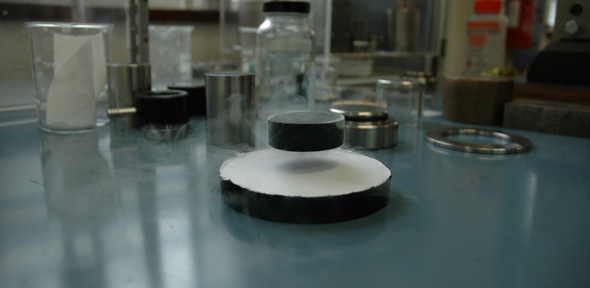By trapping a magnetic field with a strength of 17.6 Tesla, roughly 100 times stronger than the field generated by a typical fridge magnet, in a high temperature gadolinium barium copper oxide (GdBaCuO) superconductor, researchers not only beat the previous record by 0.4 Tesla, they harnessed the equivalent of three tons of force inside a golf ball-sized sample of material that is normally as brittle as fine china.
The research demonstrates the potential of high-temperature superconductors for applications in a range of fields, including flywheels for energy storage, 'magnetic separators', which can be used in mineral refinement and pollution control, and in high-speed levitating monorail trains.

Credit: Cambridge
Superconductors are materials that carry electrical current with little or no resistance when cooled below a certain temperature. While conventional superconductors need to be cooled close to absolute zero (zero degrees on the Kelvin scale, or –273 °C) before they superconduct, high temperature superconductors do so above the boiling point of liquid nitrogen (–196 °C), which makes them relatively easy to cool and cheaper to operate.
Superconductors are currently used in scientific and medical applications, such as MRI scanners, and in the future could be used to protect the national grid and increase energy efficiency, due to the amount of electrical current they can carry without losing energy.
The current carried by a superconductor also generates a magnetic field, and the more field strength that can be contained within the superconductor, the more current it can carry. State of the art, practical superconductors can carry currents that are typically 100 times greater than copper, which gives them considerable performance advantages over conventional conductors and permanent magnets.
The new record was achieved using 25 mm diameter samples of GdBCO high temperature superconductor fabricated in the form of a large, single grain using an established melt processing method and reinforced using a relatively simple technique. The previous record of 17.2 Tesla, set in 2003 by a team led by Professor Masato Murakami from the Shibaura Institute of Technology in Japan, used a highly specialized type of superconductor of a similar, but subtly different, composition and structure.
"The fact that this record has stood for so long shows just how demanding this field really is," said Professor David Cardwell of Cambridge's Department of Engineering, who led the research, in collaboration with Boeing and the National High Field Magnet Laboratory at the Florida State University. "There are real potential gains to be had with even small increases in field."
To contain such a large field, the team used materials known as cuprates: thin sheets of copper and oxygen separated by more complex types of atoms. The cuprates were the earliest high temperature superconductors to be discovered, and have the potential to be used widely in scientific and medical applications.
While they are high quality superconductors with outstanding potential for practical applications, the cuprates can be as brittle as dried pasta when fabricated in the form of sintered ceramics, so trying to contain a strong magnetic field within bulk forms of the cuprates tends to cause them to explode.
In order to hold in, or trap, the magnetic field, the researchers had to modify both the microstructure of GdBaCuO to increase its current carrying and thermal performance, and reinforce it with a stainless steel ring, which was used to 'shrink-wrap' the single grain samples. "This was an important step in achieving this result," said Dr John Durrell who led the experiment in Florida.
The lines of magnetic flux in a superconductor repel each other strongly, making containing such a large field difficult. But, by engineering the bulk microstructure, the field is retained in the sample by so-called 'flux pinning centres' distributed throughout the material. "The development of effective pinning sites in GdBCO has been key to this success," said Dr Yun-Hua Shi, who has been responsible for developing the melt process fabrication technique at Cambridge for the past 20 years.
The result was the biggest ever trapped field achieved in a bulk, standalone material at any temperature.
"This work could herald the arrival of superconductors in real-world applications," said Professor Cardwell. "In order to see bulk superconductors applied for everyday use, we need large grains of superconducting material with the required properties that can be manufactured by relatively standard processes."
A number of niche applications are currently being developed by the Cambridge team and its collaborators, and it is anticipated that widespread commercial applications for superconductors could be seen within the next five years.
"This record could not have been achieved without the support of our academic and industrial colleagues and partners," said Professor Cardwell, who is the next Head of the Department of Engineering. "It was a real team effort, and one which we hope will bring these materials a significant step closer to practical applications."
"Boeing continues to see practical applications for this superconducting material research and we are excited about the possibilities being enabled by the recent advances achieved by the Cambridge team," said Patrick Stokes, who leads the Boeing-funded research portfolio with Cambridge University.





Comments